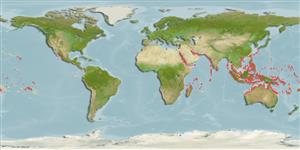Environment: milieu / climate zone / depth range / distribution range
Ökologie
seewasser riff-verbunden; tiefenbereich 1 - 15 m (Ref. 90102). Tropical; 30°N - 24°S
Indo-West Pacific: Maldives (Ref. 30829) and Mauritius to Indonesia, Singapore, the Philippines, Papua New Guinea and the Solomon Islands. Recently reported from New Caledonia (Ref. 11889).
Size / Gewicht / Alter
Maturity: Lm ? range ? - ? cm
Max length : 15.0 cm TL Männchen/unbestimmt; (Ref. 48635)
Kurzbeschreibung
Morphologie | Morphometrie
Rückenflossenstacheln (insgesamt): 3; Rückenflossenweichstrahlen (insgesamt): 11-12; Afterflossenstacheln 0; Afterflossenweichstrahlen: 6 - 7. Characterized by numerous prominent wart-like protuberances on its skin and a large esca that mimics a tiny fish. Bony part of the illicium with numerous crossbands and approximately twice as long as the 2nd dorsal spine. Coloration is highly variable, ranging from cream to yellow, brown, or black with scattered dark circular spots and saddles or blotches ranging from white to pink, rust-red, or red. Heavily spotted individuals resemble A. pictus. Usually has red or orange margins on all fins and the first band across the body diverts to the posterior edge of the eye which distinguishes it from A. pictus (Ref. 48635).
Inhabit sheltered rocky reefs (Ref. 559). Adults are usually with sponges (Ref. 48635). Juveniles openly on reefs looking like nudibranchs (Ref. 48635). Feeds on fishes (Ref. 89972). Oviparous. Eggs are bound in ribbon-like sheath or mass of gelatinous mucus called 'egg raft' or 'veil' (Ref. 6773). Solitary, frequently among algae, sponges and soft corals (Ref 90102).
Life cycle and mating behavior
Geschlechtsreife | Fortpflanzung | Ablaichen | Eier | Fecundity | Larven
Oviparous. Eggs are bound in ribbon-like sheath or mass of gelatinous mucus called 'egg raft' or 'veil' (Ref. 6773).
Pietsch, T.W. and D.B. Grobecker, 1987. Frogfishes of the world. Systematics, zoogeography, and behavioral ecology. Stanford University Press, Stanford, California. 420 p. (Ref. 6773)
IUCN Rote Liste Status (Ref. 130435)
Bedrohung für Menschen
Harmless
Nutzung durch Menschen
Fischereien: nicht kommerziell; Aquarium: Kommerziell
Mehr Information
Alter/GrößeWachstumLänge-GewichtLänge-LängeLängenhäufigkeitenMorphometrieMorphologieLarvenLarven Pop.Dyn.RekrutierungDichteBRUVS
ReferenzenAquakulturAquakultur ProfilZuchtlinienGenetikElectrophoresesVererbbarkeitKrankheitenVerarbeitungNutrientsMass conversion
PartnerBilderStamps, Coins Misc.LauteCiguateraGeschwindigkeitSchwimmstilKiemenoberflächeOtolithsGehirngrößeSehfähigkeit
Tools
Zusatzinformationen
Download XML
Internet Quellen
Estimates based on models
Preferred temperature (Ref.
123201): 25.2 - 29.3, mean 28.5 °C (based on 3049 cells).
Phylogenetic diversity index (Ref.
82804): PD
50 = 0.5005 [Uniqueness, from 0.5 = low to 2.0 = high].
Bayesian length-weight: a=0.01995 (0.00906 - 0.04395), b=3.01 (2.83 - 3.19), in cm total length, based on all LWR estimates for this body shape (Ref.
93245).
Trophic level (Ref.
69278): 4.2 ±0.73 se; based on food items.
Widerstandsfähigkeit (Ref.
120179): hoch, Verdopplung der Population dauert weniger als 15 Monate. (Fec assumed to be > 10,000).
Fishing Vulnerability (Ref.
59153): Low vulnerability (10 of 100).
